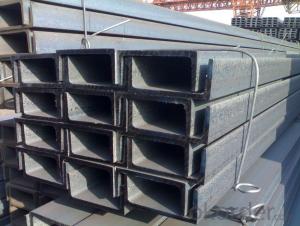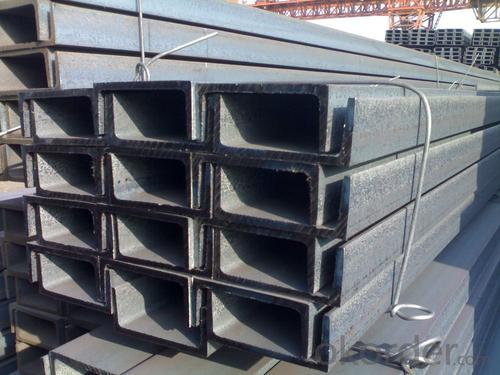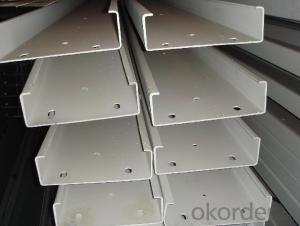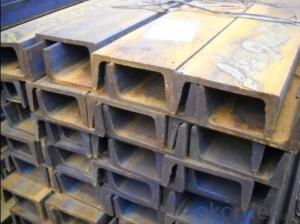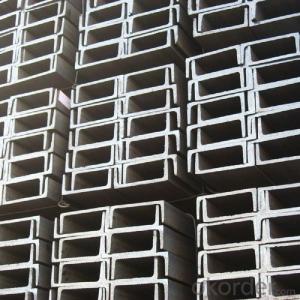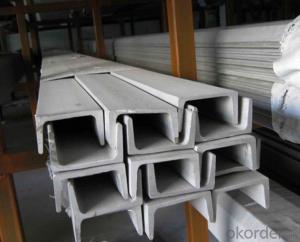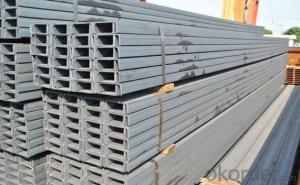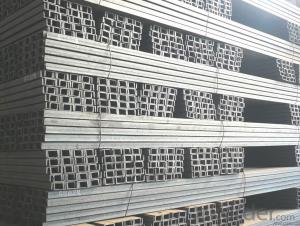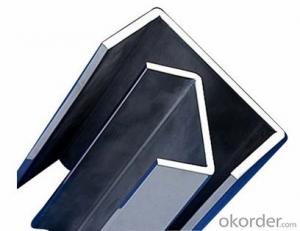Steel U Channel With Higher Yield Point
- Loading Port:
- China main port
- Payment Terms:
- TT or LC
- Min Order Qty:
- 50 m.t.
- Supply Capability:
- 50000 m.t./month
OKorder Service Pledge
OKorder Financial Service
You Might Also Like
Description
In the production of steel products, steel is molded and reshaped with different machinery at different temperatures. One process is steel rolling, which involves metal stock passing through a pair of rolls. Rolling produces flat steel sheets of a specific thickness, and the process is classified according to the temperature at which the metal is rolled. If the temperature of the metal is above its recrystallization temperature, or the temperature at which the grain structure of the metal can be altered, then the process is termed as hot rolling. If the temperature of the metal is below its recrystallization temperature, the process is termed as cold rolling.
Like cold rolling, cold drawing is performed at room temperature, but instead of producing a flat object like a coke can, cold drawing makes steel into the form of a wire like the spokes of a wheel or a paper clip. To start the process, Steel is usual hammered and rolled so that it can be fit through a die; a tool that turns the steel mass into a wire. The room temperature steel is pulled through the die which reshapes it into a thinner shape while maintaining the same volume. It is similar to the idea of syrup flowing out of a bottle through a tube in that it changes shape but not volume, but instead of squeezing the metal, it is pulled out. In order to get the wire down to the right diameter, it usually requires more than one pass through different dies.
Chemical Compostion
Grade | Element(%) | |||
C | Mn | P | S | |
SS330 | -- | -- | ≦0.050 | ≦0.050 |
SS400 | ||||
SS490 | ||||
SS540 | ≦0.30 | ≦1.60 | ≦0.040 | ≦0.040 |
Usage/Applications
Channel Steel is usually used for building structure, vehicle manufacturing and other industrial structure and often used with i beam.
In details, the channel steel belongs to carbon structural steel which is applied to in the field of construction and machinery. The channel steel is usually used for arch-itechtural structure, and they could be welded in order to support or hang a vari-ety of facilities. They are also usually used in combination with I beam. Generally,the channel steel must possess perfect welding property, riveting property and mechanical property and so on.
FAQ:
Q1: Why buy Materials & Equipment from OKorder.com?
A1: All products offered byOKorder.com are carefully selected from China's most reliable manufacturing enterprises. Through its ISO certifications, OKorder.com adheres to the highest standards and a commitment to supply chain safety and customer satisfaction.
Q2: How do we guarantee the quality of our products?
A2: We have established an advanced quality management system which conducts strict quality tests at every step, from raw materials to the final product. At the same time, we provide extensive follow-up service assurances as required.
Q3: Can stainless steel rust?
A3: Stainless does not "rust" as you think of regular steel rusting with a red oxide on the surface that flakes off. If you see red rust it is probably due to some iron particles that have contaminated the surface of the stainless steel and it is these iron particles that are rusting. Look at the source of the rusting and see if you can remove it from the surface.
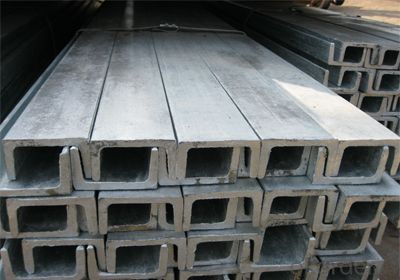

- Q: Are steel channels suitable for the oil and gas manufacturing industry?
- Yes, steel channels are suitable for the oil and gas manufacturing industry. Steel channels provide excellent strength and durability, making them ideal for supporting heavy equipment and structures commonly used in the industry. Additionally, steel channels can withstand harsh environmental conditions, including extreme temperatures and corrosion, making them a reliable choice for oil and gas operations.
- Q: Can steel channels be used for mezzanine guardrails?
- Yes, steel channels can be used for mezzanine guardrails. Steel channels are often used for their strength and durability, making them suitable for providing a secure barrier and ensuring the safety of individuals on mezzanine floors.
- Q: After the type of channel is not marked A or B, which shall be calculated?
- The type of channel is not calculated or selected according to the best principle when it is not marked "A" or "B":1) if it is the construction side, according to A model selection calculation, the most material, the lowest cost;2) if it is the owner, according to B model selection calculation, higher strength, greater safety factor.
- Q: How do steel channels perform in extreme temperatures?
- Steel channels are renowned for their exceptional performance in extreme temperatures, exhibiting a remarkable ability to withstand high heat without warping or deforming due to their high melting point. As a result, they find extensive use in industries demanding heat resistance, such as automotive, aerospace, and construction sectors. In addition, steel channels exhibit impressive performance even in frigid temperatures. This is attributed to the fact that steel possesses a low coefficient of thermal expansion, meaning it undergoes minimal contraction or expansion when subjected to temperature fluctuations. Consequently, steel channels retain their structural integrity and dimensional stability even in freezing conditions. Moreover, steel channels boast excellent thermal conductivity, enabling efficient heat transfer. This attribute proves particularly advantageous in extreme temperature environments, as it ensures the uniform distribution of heat, preventing the formation of localized hot spots or cold spots. Taken together, the reliability of steel channels in extreme temperatures renders them the preferred choice for various applications where temperature resistance is of utmost importance.
- Q: What are the different types of loads that steel channels can bear?
- Steel channels exhibit versatility as structural components capable of bearing different types of loads. The array of loads they can endure includes: 1. Compression Load: With a high load-bearing capacity, steel channels can effectively withstand compression forces. They find common usage in columns and beams, providing support for the weight of structures and facilitating vertical load transfer. 2. Tension Load: Steel channels possess the capability to resist tension loads, effectively countering forces that aim to pull or stretch the material. This attribute renders them appropriate for applications such as trusses or suspension systems. 3. Shear Load: Steel channels exhibit resilience against shear forces, which arise when two parallel forces exert themselves in opposite directions. They frequently find application in structural systems, effectively counteracting the shearing effects of horizontal loads like wind or seismic forces. 4. Bending Load: Steel channels proficiently bear bending loads, which emerge when forces are applied perpendicularly to the channel's axis. They are often utilized as beams or lintels, providing support for loads positioned over openings like doors or windows. 5. Axial Load: Steel channels are designed specifically to withstand axial loads, which act along the channel's longitudinal axis. These loads can either be compressive or tensile and are typically encountered in columns or vertical members. 6. Lateral Load: Steel channels possess the ability to bear lateral loads, which exert themselves perpendicular to the channel's longitudinal axis. These loads commonly originate from wind, earthquakes, or other horizontal forces and are effectively countered by the structural system incorporating the channel. In conclusion, steel channels offer a versatile option for structural applications due to their capacity to bear various types of loads. Their strength, durability, and flexibility render them suitable for an extensive range of construction and engineering projects.
- Q: Are steel channels suitable for use in conveyor systems?
- Yes, steel channels are commonly used in conveyor systems due to their strength, durability, and versatility. They provide excellent support for heavy loads and can withstand the rigors of continuous operation, making them suitable for use in conveyor systems.
- Q: How are steel channels measured?
- Steel channels are typically measured using two key dimensions: the height and the width. The height refers to the vertical measurement from the top to the bottom of the channel, while the width refers to the horizontal measurement from one side to the other. These dimensions are important as they determine the size and shape of the channel, which in turn affects its strength and load-bearing capacity. Additionally, the thickness of the steel used to make the channel is also considered when measuring it. This measurement is usually given in gauge or millimeters and represents the thickness of the steel walls of the channel. By knowing the height, width, and thickness, one can determine the overall dimensions and characteristics of a steel channel, enabling it to be used effectively in various construction and manufacturing applications.
- Q: Can steel channels be used in railway infrastructure projects?
- Yes, steel channels can certainly be used in railway infrastructure projects. Steel channels provide structural support and can be used for various applications such as track support, bridge construction, and platform framing. They offer strength, durability, and the ability to withstand heavy loads, making them suitable for railway projects.
- Q: What are the design considerations when using steel channels?
- There are several important factors to consider when using steel channels in design. To begin with, it is crucial to calculate the load-bearing capacity of the steel channel accurately. This involves determining the maximum load that the channel will endure and ensuring that the chosen channel size and shape can adequately support this load without any deformation or failure. Factors such as material strength, cross-sectional shape, and channel size must be taken into account. Another consideration of utmost importance is the structural stability of the steel channel. It is vital to evaluate whether the channel will face any external forces or vibrations and design it in a way that it can resist these forces without buckling or collapsing. This may involve incorporating reinforcements or bracing elements to enhance the channel's stability. Additionally, the environmental conditions in which the steel channel will be used should be considered. Factors like temperature fluctuations, exposure to corrosive substances, or the potential for moisture accumulation can affect the performance and durability of the steel channel. Appropriate measures, such as protective coatings or material selection, should be implemented to ensure the long-term functionality and integrity of the channel. Moreover, when designing with steel channels, it is essential to consider the ease of fabrication, installation, and maintenance. The selected channel size and shape should be compatible with standard manufacturing processes and construction techniques, allowing for efficient installation in the desired application. Additionally, potential future maintenance requirements, such as accessibility for repairs or modifications, should be taken into account. Lastly, the aesthetic and architectural requirements of the project should not be overlooked. Steel channels can serve as architectural elements, and their design should align with the overall aesthetic vision of the project. This may involve selecting a specific finish or surface treatment that complements the desired appearance. In summary, the design considerations for steel channels encompass load-bearing capacity, structural stability, environmental conditions, fabrication and installation feasibility, maintenance requirements, and aesthetic compatibility. By carefully addressing these factors, designers can ensure the successful implementation of steel channels in their projects.
- Q: Can steel channels be customized according to specific requirements?
- Yes, steel channels can be customized according to specific requirements. Manufacturers can tailor the dimensions, lengths, thicknesses, and finishes of steel channels to meet the specific needs and preferences of customers.
Send your message to us
Steel U Channel With Higher Yield Point
- Loading Port:
- China main port
- Payment Terms:
- TT or LC
- Min Order Qty:
- 50 m.t.
- Supply Capability:
- 50000 m.t./month
OKorder Service Pledge
OKorder Financial Service
Similar products
Hot products
Hot Searches
Related keywords
